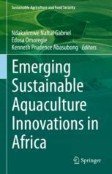Search
Search Results
-
Structural and immunohistochemical analysis of the cellular compositions of the liver of molly fish (Poecilia sphenops), focusing on its immune role
The liver of fish is considered an ideal model for studying the collaboration between environmental agents and the health state of the fish, where it...

-
Implications of Heavy Metal Accumulation in Fish Feed, Water, Sediment, and Different Fish Species in a Polyculture System
Heavy metal bioaccumulation in organisms is primarily a result of dietary uptake. The current study examines the concentrations of heavy metals (Pb,...

-
Heavy Metal Bioaccumulation in Highly Consumed Pelagic and Benthic Fish and Associated Health Risk
The present study investigated the levels of Manganese (Mn), Cadmium (Cd), Copper (Cu), Zinc (Zn), Lead (Pb) and Iron (Fe) in the tissues of a...

-
Food and Biomedical Applications of Fish Proteins
Fish-based diet and its health/nutritional benefits and global public awareness are on the rise. The fish protein and other bioactive compounds have...
-
Factors Affecting Fish Migration
Multiple environmental and endogenous elements work together to cause fish migrations. Abiotic and biotic environmental conditions, such as seasonal...
-
Adaptive Mechanisms of Fish under Conditions of Ammonia Toxicity
AbstractAmmonia is the main excretory substance resulting from the catabolism of proteins and amino acids in most aquatic animals, especially in...

-
Transgenic Fish Production
An organism that has a foreign or modified gene in its genome is called transgenic or GMO. A genetically modified organism (GMO) is an organism whose...
-
Fish Nutrition: An African Aquaculture Perspective
Aquaculture production is an essential industry in many African countries as a source of protein, income, and employment. The industry is expected to...
-
Comparative Characteristics of the Physiological State of Pikeperch (Sander Lucioperca) from Various Habitat Conditions: Lake (Natural Habitat), Ponds, and Fish Farm Cages
AbstractStudies of the physiological state of 3-year-old pikeperch from a lake (natural habitat), ponds, and fish farm cages show significant...

-
Heavy Metal Concentrations in Water, Sediment, and Fish Species in Chashma Barrage, Indus River: A Comprehensive Health Risk Assessment
The increasing levels of heavy metals in aquatic environments, driven by human activities, pose a critical threat to ecosystems’ overall health and...

-
Fish as a Sustainable Biomonitoring Tool in Aquatic Environments
Biomonitoring involves the use of biological organisms to detect or measure the presence of various toxic substances rather on land or in water. Fish...
-
Differences in diacylglycerol acyltransferases expression patterns and regulation cause distinct hepatic triglyceride deposition in fish
Triglyceride (TAG) deposition in the liver is associated with metabolic disorders. In lower vertebrate, the propensity to accumulate hepatic TAG...

-
Methods to Study Liver Disease Using Zebrafish Larvae
Liver disease affects millions of people worldwide, and the high morbidity and mortality is attributed in part to the paucity of treatment options....
-
Assessment and Bioaccumulation of Heavy Metals in Water, Fish (wild and Farmed) and Associated Human Health Risk
Worldwide, anthropogenic activities are causing the natural environment and aquaculture systems to become heavily contaminated with heavy metals,...

-
Ecotoxicology Methods of Reservoir Water Using Fish
This chapter aims at elucidating the use of model fish species in ecotoxicological studies and the methodology of ecotoxicity testing based on fish....
-
Soluble non-starch polysaccharides in fish feed: implications for fish metabolism
Because of their unique glycosidic bond structure, non-starch polysaccharides (NSP) are difficult for the stomach to break down. NSP can be...

-
Potentials of Aloe barbadensis inclusion in fish feeds on resilience to Aeromonas hydrophila infection in freshwater fish Labeo rohita
Aquatic bacterial pathogens can cause severe economic loss in aquaculture industry. An opportunistic pathogen, Aeromonas hydrophila is responsible...

-
Innovations in Fish Processing Technology
Globally, fish has been realized as a nature’s super-food with the global per capita availability for consumption of 20.2 kg/year/person. Aquatic...
-
Fish Macrophages
Fish macrophages arise from haematopoietic progenitors in the head kidney and differentiate into tissue macrophage subtypes and/or self-maintaining...
-
Comparative transcriptome and adaptive evolution analysis on the main liver and attaching liver of Pareuchiloglanis macrotrema
Pareuchiloglanis macrotrema is a glyptosternoid fish belonging to the Siluriform family and is endemic to the Qinghai-Tibet Plateau tributaries. P....

